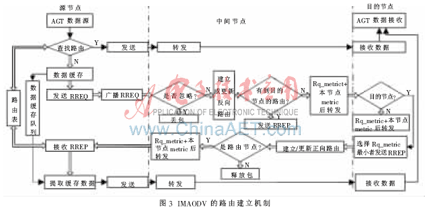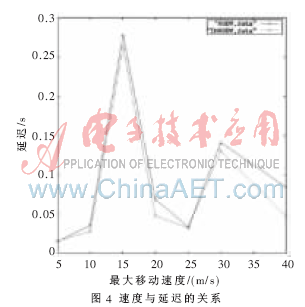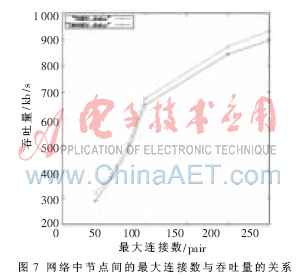The traditional AODV (Ad-hoc On-demand Distance Vector) routing protocol only uses the number of route hops as a measure, without considering the link stability. Therefore, it cannot better adapt to the network environment where nodes move at high speed.
To this end, an improved AODV routing protocol is proposed, namely IMAODV (Improved AODV) routing protocol. The protocol mainly improves AODV from several aspects such as routing metric value, the frequency of sending HELLO messages, and the monitoring method of neighboring nodes, so that it has better scalability and robustness in mobile networks. The simulation results show that the IMAODV protocol can better adapt to the high-speed mobile network environment, and reduce the network delay and increase the network throughput to a certain extent.
Mobile ad hoc network (MANET) is a multi-hop self-organizing network system composed of a series of mobile terminals without a fixed infrastructure [1]. Its topology changes due to insufficient node power or movement. Therefore, MANET routing protocol and traditional Network routing protocols are very different.
At present, the more mature and typical routing protocols in mobile networks are DSDV, DSR, AODV, ZRP, etc. [2]. Among them, AODV routing protocol [3] is a classic on-demand routing protocol, it has a smaller routing overhead and better expansion performance than other protocols to a certain extent, but this routing protocol frequently changes in the network topology In this case, there is a high probability of routing broken links, and its network performance declines rapidly, which cannot guarantee the higher quality of service required.
In view of the characteristics of high-speed mobile ad hoc networks, this paper proposes an improved routing protocol based on AODV, namely IMAODV, which has been modified in routing metrics, broken link repair strategy and HELLO message mechanism, so that it can effectively reduce network latency To improve network throughput. Through NS2 simulation, we can see that the IMAODV routing protocol proposed in this paper has certain advantages compared with the traditional AODV routing protocol: it can not only reduce the network delay of high-speed mobile ad hoc networks, but also improve network throughput to a certain extent. At the same time, IMAODV routing protocol can better adapt to the wireless network environment and effectively improve network performance.
1 IMAODV routing algorithm
1.1 AODV
Traditional ad hoc network routing protocols can be divided into active routing protocols and on-demand routing protocols [4]. Because mobile ad hoc networks have dynamic and variable characteristics, the application of active routing protocols in mobile networks has obvious defects, so it is often practiced in practice. All the on-demand routing protocols are used [5].
AODV is a classic routing protocol for Ad-hoc networks. It consists of route discovery and route maintenance. The route discovery process is shown in Figure 1. In the route maintenance, the node maintains the connection with the neighboring node by periodically sending the HELLO packet. If the HELLO packet of the neighboring node has not been received after a period of time, the link repair process starts. If the local node is closer to the destination node, local repair is performed, and RREQ is sent for route reconstruction. When the intermediate node has an effective route to the unreachable node or the unreachable node receives this RREQ, it sends a route reply RREP to the source node. This way the route is rebuilt. If the link repair fails, the node broadcasts a RERR packet to all neighbor nodes. The list of unreachable nodes in the RERR packet includes not only the neighbor node with the link down, but also all the purposes of using the neighbor node as the next hop. node. Through the RERR broadcast, other nodes will know that the link is broken, and when this packet is transmitted to the source node, a new round of route discovery will be performed.

1.2 Although the IMAODV routing algorithm AODV can also adapt to dynamically changing networks, its mechanism is not flexible, and it cannot dynamically adjust the transmission frequency according to the network environment. Furthermore, the routing metric only considers the hop count information, and the routing is single, so it cannot be satisfied. A network environment where the mobile environment is more complex or the moving speed is higher. In order to better meet the service requirements of mobile ad hoc networks, this paper will make the following improvements to the IMAODV proposed for high-speed mobile environments on the basis of the AODV protocol to improve network throughput and average end-to-end delay.
1.2.1 Selection of node metric value AODV with hops as a measure can easily cause a large amount of data transmission through a small number of nodes to cause network congestion, resulting in excessive packet delay and reduced throughput [6]. In order to alleviate this situation, this article will consider the following factors in the selection of routing metrics:
Node movement speed: The higher the node movement speed, the more unstable the link. Therefore, when selecting a route, choose an intermediate node with a lower movement speed to avoid the restart process of the broken link route caused by the node movement to reduce network overhead.
Delay: In the routing process, the smaller the delay, the data transmission can show its timeliness.
Hop count: The smaller the hop count, to a certain extent, the less network resources are consumed.
Considering the computational complexity of the node, the routing metric value: 
Where hop represents the number of hops, nodenum represents the total number of nodes in the network, delay represents the delay from the last hop node to this node, speed represents the movement speed of this node, max speed represents the maximum movement speed of the nodes in the network, w1, w2 and w3 Respectively represent weights, where w1 + w2 + w3 = 1, the values ​​of w1, w2 and w3 in this agreement are taken as 0.7, 0.2 and 0.1 respectively. When the value of metric is smaller, the stability of the routing link is higher, and the network delay is smaller.
1.2.2 Improvement of node function In traditional AODV, the source node only keeps one route to the destination node. When the link on the main route is disconnected, the source node restarts route discovery with a higher probability, which may cause excessive routing costs and Large delay. In order to improve this situation, the IMAODV proposed in this paper uses RREP information sent by neighboring nodes that are heard by the broadcast channel in wireless communication to other nodes to establish a backup route [7-8]. By adding the function of the node, it can be monitored. The ability to route control information.
1.2.3 Improvement of Hello mechanism IMAODV made two improvements to the HELLO message: (1) It sets a flag for the HELLO message. Initialized to TURE, the node sends a HELLO message. When the node has routing or data information that needs to be broadcast, the flag is set to FALSE. If the HELLO sending cycle comes again, check the flag first, if it is FALSE, then change the status to TURE without any processing, and continue to check the flag until the next cycle arrives; when the flag is TURE, send a HELLO message, and at the same time When a node receives a routing packet or data packet, it needs to update the neighbor's survival time, which can reduce the overhead of sending HELLO messages. (2) Due to the movement of the node, the network topology will be changed. The fixed transmission of HELLO messages must not effectively capture the network topology information. In order to ensure the effectiveness of the link, this article will adjust the HELLO packet according to the speed of the node itself Sending frequency, the sending frequency is proportional to the moving speed of the node, the process is shown in Figure 2.

1.2.4 Improvement of link repair Because each node in the IMAODV route has a listen function for the route reply packet, the one-hop neighbors of the nodes on the main path can listen to this packet, so they can pass through the nodes on the main path Establish a route to the destination node, thus forming multiple backup routes to the destination node. When a link on the main route is disconnected, the RREQ can be used to request local repair. In order to reduce the cost of routing requests, this article sets the lifetime of the routing request to 2 hops. When the intermediate node receives the routing request, if the routing lifetime is not 0, it finds whether it has a route to the destination node. If there is, it responds in the same way as the original AODV. If not, it continues to broadcast the routing request message until the lifetime becomes 0 and discards the packet. When the local repair fails, the node broadcasts the routing error packet again.
1.2.5 IMAODV routing protocol IMAODV adds a metric field to the routing request, routing response, and routing table to record the cumulative routing metric value of each node on the path. When the source node needs a communication route, first initialize the metric to 0, and then broadcast the RREQ packet to start the route discovery process. An rt_metric is added to the routing table segment of the intermediate node to record the minimum value of the path metric on the path from the source node to the node. When the intermediate node receives the non-repeated RREQ packet, it accumulates its own metric value on the rq_metric in the routing RREQ , And then continue to forward. If the node has received the RREQ of the same broadcast ID of the same source node, and the destination sequence number of the packet is greater than the sequence number in the routing table, the route is updated directly. If they are equal, the rq_metric and rt_metric are compared and the smaller one is selected as the routing table. The rt_metric in the entry is to update the routing table entry and then forward the packet. When the route request packet reaches the destination node, the destination node will select a route with a smaller metric and send a route reply RREP. The routing response is transmitted in unicast. When receiving this packet, the node first determines whether the node is a listening node or a normal routing response node based on the next hop information in the received packet. The next hop ID is not equal to the local node ID. Then this node is a listening node, at this time, the route recorded to the destination node is not forwarded again, otherwise it is the node on the main path, then it is processed according to the traditional AODV route response. Figure 3 shows the flow of IMAODV route establishment.
In Figure 3, the route establishment or update is determined based on the route sequence number and route metric value. If it is the first time to receive a routing request packet, the route is established; if the destination node serial number in the received request packet is greater than the destination node serial number stored in the routing table or equal to the destination serial number stored in the routing table, but the route If the route metric value in the table is greater than the route metric value in the request packet, the route is updated. "Ignore" to check whether duplicate packets are received, if yes, discard them; otherwise, update the routing table and request packet information before forwarding.

2 Simulation analysis
2.1 Simulation environment The simulation tool uses the NS-2.30 [7] version. The network topology environment is a network model containing 50 mobile nodes. The nodes are randomly distributed in a square area of ​​1 000 m × 1 000 m, and the movement of the nodes is set The speed is between 0 m / s ~ 40 m / s, the wireless interface bandwidth of each node is 2 Mb / s, the effective wireless transmission range is 250 m, the link layer adopts wireless 802.11 MAC protocol, random among 50 nodes Generate 4 pairs of constant bit rate CBR connections, each packet is 512 B in length, and send 4 packets per second. In order to investigate the performance of the improved protocol in a network simulation environment, this paper will simulate the node speed at 0 ~ 20 m / At s, the pause time (pause TIme), the maximum number of connections between nodes in the network, and the impact of changes in node speed on network throughput, as well as the impact of changes in node movement speed on the average end-to-end delay of the network, are set at the same Compared with AODV in the environment, the simulation results are given.
2.2 Simulation results and performance analysis Figure 4 shows the relationship between end-to-end delay and node moving speed. It can be seen that the average end-to-end delay of IMAODV protocol is better than AODV protocol as the node moving speed increases. The reason is that the route measurement The delay of each hop is taken into consideration, and the transmission frequency of the improved HELLO mechanism is related to the speed of node movement. It can quickly detect the situation of routing disconnection and make corresponding treatment. When the maximum speed of the node in the figure is 5 m / s, due to the low speed, the advantage of IMAODV is not prominent, and the delay is larger than that of AODV. However, as the speed of the node increases, the average end-to-end delay of IMAODV is lower than AODV; When the maximum moving speed of the node reaches 40 m / s, the delay of IMAODV is about 1/2 of that of AODV. Overall, IMAODV latency has decreased as the node's movement speed has increased.

In Figure 5, IMAODV considers the influence of the node's movement speed in the routing metric and HELLO message mechanism, and the node has the function of listening to the routing reply, so that it has multiple routes to the destination node. In this way, when the link is broken, the route can be restored in time and data transmission can be performed. As the speed of the node increases, the throughput of IMAODV is significantly better than AODV. As shown in Figure 5, the maximum moving speed of the node is 10 m / s and 15 At m / s, IMAODV can provide 29.4% and 34.3% higher network throughput than AODV.
Figure 6 reflects the relationship between node dwell time and throughput. At this time, the maximum movement speed of the node is 20 m / s, and the dwell time is 40 s, 50 s, and 150 s. The throughput of IMAODV is slightly higher than that of AODV. The reason is that the movement speed of intermediate nodes in these scenarios is relatively small. Because the routing metric in the new protocol is a compromise in many aspects, when the movement speed is not obvious, the superiority of IMAODV is not obvious, but the overall Performance is better than AODV.

Figure 7 shows the impact of increased node connections on the network throughput when the maximum node movement speed is 20 m / s. The throughput of both protocols in the figure increases as the number of node connections in the network increases. Obviously, due to the consideration of the moving speed of the node, the improved protocol can quickly capture the broken link between the nodes and make a faster route reconstruction process, so that IMAODV in the figure can produce higher throughput than AODV. .

In this paper, the AODV protocol is improved according to the influence of the moving speed of nodes in the mobile ad hoc network on the routing protocol, and a new improved routing protocol IMAODV (Improved AODV) is proposed. While the protocol optimizes the HELLO message mechanism and route repair mechanism, it is optimized at the MAC layer to enable the node to have a listening function, so that it can establish a more stable route under the condition that the node moves at medium and high speeds. It improves the average end-to-end delay of packet transmission and improves the network throughput. Simulation results show that the protocol can better adapt to the communication environment of mobile ad hoc networks.
The next step is to do multi-interface expansion and cross-layer optimization of the routing protocol to further improve the performance of the routing algorithm.
TV Antenna Description
1. Receives free broadcast High Definition TV signals (such as ABC, CBS, NBC, PBS, and Fox).
Supports 1080i, 1080 and 720p.2. UHF/VHF indoor antenna,
Suitable for DTV/HDTV/HD/DTC receiver, also support PC and NB when with connect.
3. Easily hidden behind a picture, bookshelf or television.
4. Fast and easy set up with 3 steps - Unwrap, Plug it in and Scan channels.
5. Very convenient,You can put it higher on wall; lay flat on table; place it high on window (strongly recommended), and it will provide you with opportunities to watch crystal clear digital & HD shows! If you don't want to mount the antenna on the wall/window.
6. If your location's HDTV digital terrestrial signal is weak or your place is far away from broadcast tower, you need to buy High Gain TV Antenna Amplifier.
7. Specially designed circuit produces exceptional reception with compact size.
TV Antenna Specification
Frequency Range (MHz): 174-230MHz /470-862MHz
Input Impedance (Ω): 75
V.S.W.R: ≤1.6
Gain (dBi): 25-30
Radiation: Omni
Connector: F or IEC
Cable Type: RG174
Cable Length:Typical 3M
Picture show

TV Antenna
TV Antenna, Digital Indoor TV Antenna, Outdoor TV Antenna Manufacturers and Suppliers in China
Shenzhen Yetnorson Technology Co., Ltd. , http://www.yetnorson.com